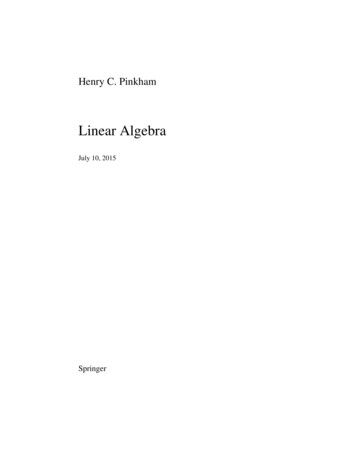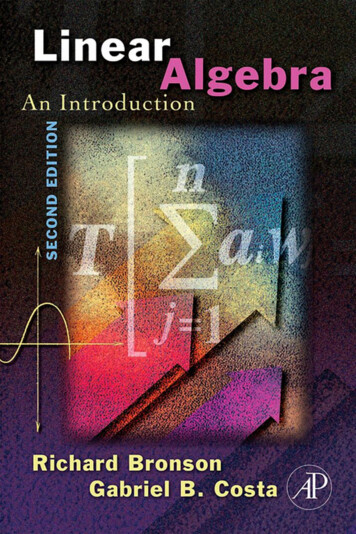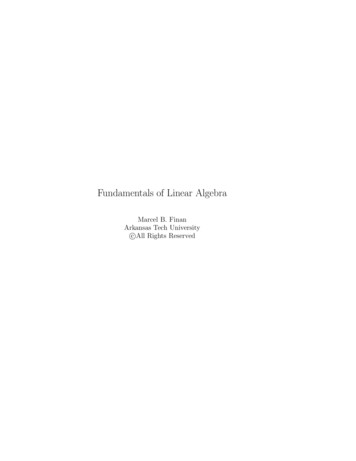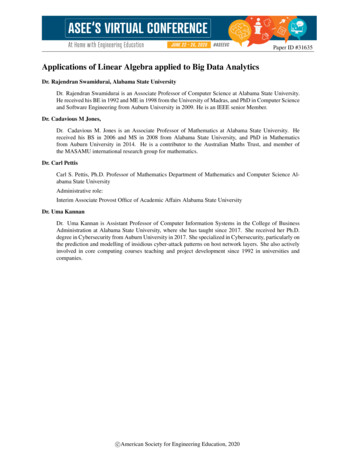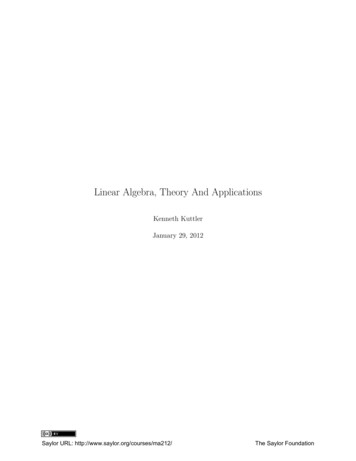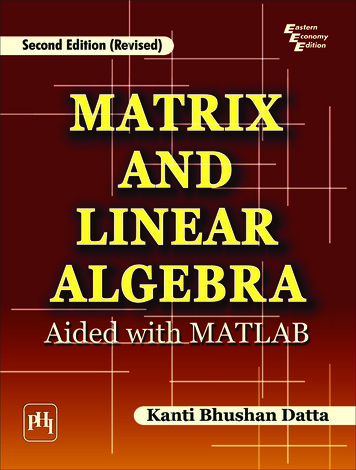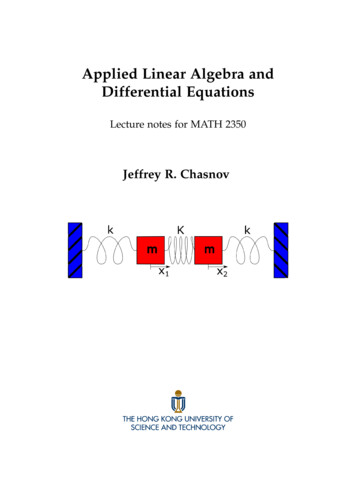
Transcription
Applied Linear Algebra andDifferential EquationsLecture notes for MATH 2350Jeffrey R. Chasnov
The Hong Kong University of Science and TechnologyDepartment of MathematicsClear Water Bay, KowloonHong Kongc 2017-2019 by Jeffrey Robert ChasnovCopyright This work is licensed under the Creative Commons Attribution 3.0 Hong Kong License. Toview a copy of this license, visit http://creativecommons.org/licenses/by/3.0/hk/ or senda letter to Creative Commons, 171 Second Street, Suite 300, San Francisco, California, 94105,USA.
PrefaceWhat follows are my lecture notes for a mathematics course offered to second-yearengineering students at the the Hong Kong University of Science and Technology.Material from our usual courses on linear algebra and differential equations havebeen combined into a single course (essentially, two half-semester courses) at therequest of our Engineering School. I have tried my best to select the most essentialand interesting topics from both courses, and to show how knowledge of linearalgebra can improve students’ understanding of differential equations.All web surfers are welcome to download these notes and to use the notes andvideos freely for teaching and learning.I also have some online courses on Coursera. You can click on the links below toexplore these courses.If you want to learn differential equations, have a look atDifferential Equations for EngineersIf your interests are matrices and elementary linear algebra, tryMatrix Algebra for EngineersIf you want to learn vector calculus (also known as multivariable calculus, or calculus three), you can sign up forVector Calculus for EngineersAnd if your interest is numerical methods, have a go atNumerical Methods for EngineersJeffrey R. ChasnovHong KongJanuary 2020iii
Contents0A short mathematical review0.1 The trigonometric functions . . . . . . . . . . . . . .0.2 The exponential function and the natural logarithm0.3 Definition of the derivative . . . . . . . . . . . . . .0.4 Differentiating a combination of functions . . . . .0.4.1 The sum or difference rule . . . . . . . . . .0.4.2 The product rule . . . . . . . . . . . . . . . .0.4.3 The quotient rule . . . . . . . . . . . . . . . .0.4.4 The chain rule . . . . . . . . . . . . . . . . . .0.5 Differentiating elementary functions . . . . . . . . .0.5.1 The power rule . . . . . . . . . . . . . . . . .0.5.2 Trigonometric functions . . . . . . . . . . . .0.5.3 Exponential and natural logarithm functions0.6 Definition of the integral . . . . . . . . . . . . . . . .0.7 The fundamental theorem of calculus . . . . . . . .0.8 Definite and indefinite integrals . . . . . . . . . . . .0.9 Indefinite integrals of elementary functions . . . . .0.10 Substitution . . . . . . . . . . . . . . . . . . . . . . .0.11 Integration by parts . . . . . . . . . . . . . . . . . . .0.12 Taylor series . . . . . . . . . . . . . . . . . . . . . . .0.13 Functions of several variables . . . . . . . . . . . . .0.14 Complex numbers . . . . . . . . . . . . . . . . . . .1112222223333345566678ILinear algebra131Matrices1.1 Definition of a matrix . . . . . . . . . . . . .1.2 Addition and multiplication of matrices . .1.3 The identity matrix and the zero matrix . .1.4 General notation, transposes, and inverses1.5 Rotation matrices and orthogonal matrices1.6 Matrix representation of complex numbers1.7 Permutation matrices . . . . . . . . . . . . .1.8 Projection matrices . . . . . . . . . . . . . .171717191923242526Systems of linear equations2.1 Gaussian Elimination . . . . . . . .2.2 When there is no unique solution .2.3 Reduced row echelon form . . . .2.4 Computing inverses . . . . . . . .2.5 LU decomposition . . . . . . . . .2727282930312v.
CONTENTS345IIVector spaces3.1 Vector spaces . . . . . . . . . . . . . . . . .3.2 Linear independence . . . . . . . . . . . . .3.3 Span, basis and dimension . . . . . . . . . .3.4 Inner product spaces . . . . . . . . . . . . .3.5 Vector spaces of a matrix . . . . . . . . . . .3.5.1 Null space . . . . . . . . . . . . . . .3.5.2 Application of the null space . . . .3.5.3 Column space . . . . . . . . . . . . .3.5.4 Row space, left null space and rank3.6 Gram-Schmidt process . . . . . . . . . . . .3.7 Orthogonal projections . . . . . . . . . . . .3.8 QR factorization . . . . . . . . . . . . . . . .3.9 The least-squares problem . . . . . . . . . .3.10 Solution of the least-squares problem . . .353537373940404142434446464850Determinants4.1 Two-by-two and three-by-three determinants4.2 Laplace expansion and Leibniz formula . . .4.3 Properties of the determinant . . . . . . . . .4.4 Use of determinants in Vector Calculus . . .5353545560Eigenvalues and eigenvectors635.1 The eigenvalue problem . . . . . . . . . . . . . . . . . . . . . . . . . . . 635.2 Matrix diagonalization . . . . . . . . . . . . . . . . . . . . . . . . . . . . 665.3 Symmetric and Hermitian matrices . . . . . . . . . . . . . . . . . . . . . 68Differential equations696Introduction to odes736.1 The simplest type of differential equation . . . . . . . . . . . . . . . . . 737First-order odes7.1 The Euler method . . . . . .7.2 Separable equations . . . .7.3 Linear equations . . . . . .7.4 Applications . . . . . . . . .7.4.1 Compound interest .7.4.2 Chemical reactions .7.4.3 Terminal velocity . .7.4.4 Escape velocity . . .7.4.5 RC circuit . . . . . .7.4.6 The logistic equation8vi.Second-order odes, constant coefficients8.1 The Euler method . . . . . . . . . . . . .8.2 The principle of superposition . . . . .8.3 The Wronskian . . . . . . . . . . . . . .8.4 Homogeneous odes . . . . . . . . . . . .8.4.1 Distinct real roots . . . . . . . . .8.4.2 Distinct complex-conjugate 6
CONTENTS8.58.68.78.88.998.4.3 Degenerate rootsDifference equations . .Inhomogeneous odes . .Resonance . . . . . . . .Applications . . . . . . .8.8.1 RLC circuit . . .8.8.2 Mass on a spring8.8.3 Pendulum . . . .Damped resonance . . .9899100104107107109110111Series solutions1139.1 Ordinary points . . . . . . . . . . . . . . . . . . . . . . . . . . . . . . . . 11310 Systems of linear differential equations10.1 Distinct real eigenvalues . . . . . . . . . . .10.2 Solution by diagonalization . . . . . . . . .10.3 Solution by the matrix exponential . . . . .10.4 Distinct complex-conjugate eigenvalues . .10.5 Repeated eigenvalues with one eigenvector10.6 Normal modes . . . . . . . . . . . . . . . . .11911912112212312512711 Nonlinear differential equations11.1 Fixed points and stability . . . . . . . . . . . . . . . . .11.1.1 One dimension . . . . . . . . . . . . . . . . . . .11.1.2 Two dimensions . . . . . . . . . . . . . . . . . .11.2 Bifurcation theory . . . . . . . . . . . . . . . . . . . . . .11.2.1 Saddle-node bifurcation . . . . . . . . . . . . . .11.2.2 Transcritical bifurcation . . . . . . . . . . . . . .11.2.3 Supercritical pitchfork bifurcation . . . . . . . .11.2.4 Subcritical pitchfork bifurcation . . . . . . . . .11.2.5 Application: a mathematical model of a fishery.131131131132134135136137137140CONTENTS.vii
CONTENTSviiiCONTENTS
Chapter 0A short mathematical reviewA basic understanding of pre-calculus, calculus, and complex numbers is required for this course. This zero chapter presents a concise review.0.1The trigonometric functionsThe Pythagorean trigonometric identity issin2 x cos2 x 1,and the addition theorems aresin( x y) sin( x ) cos(y) cos( x ) sin(y),cos( x y) cos( x ) cos(y) sin( x ) sin(y).Also, the values of sin x in the first quadrant can be remembered by the rule ofquarters, with 0 0, 30 π/6, 45 π/4, 60 π/3, 90 π/2:rrr012 sin 0 ,sin 30 ,sin 45 ,444rr34sin 60 ,sin 90 .44The following symmetry properties are also useful:sin(π/2 x ) cos x,cos(π/2 x ) sin x;andsin( x ) sin( x ),0.2cos( x ) cos( x ).The exponential function and the natural logarithmThe transcendental number e, approximately 2.71828, is defined as 1 ne lim 1 .n nThe exponential function exp ( x ) e x and natural logarithm ln x are inverse functions satisfyingeln x x, ln e x x.The usual rules of exponents apply:e x ey e x y ,e x /ey e x y ,(e x ) p e px .The corresponding rules for the logarithmic function areln ( xy) ln x ln y,ln ( x/y) ln x ln y,1ln x p p ln x.
0.3. DEFINITION OF THE DERIVATIVE0.3Definition of the derivativeThe derivative of the function y f ( x ), denoted as f 0 ( x ) or dy/dx, is defined asthe slope of the tangent line to the curve y f ( x ) at the point ( x, y). This slope isobtained by a limit, and is defined asf 0 ( x ) limh 00.40.4.1f ( x h) f ( x ).h(1)Differentiating a combination of functionsThe sum or difference ruleThe derivative of the sum of f ( x ) and g( x ) is( f g)0 f 0 g0 .Similarly, the derivative of the difference is( f g)0 f 0 g0 .0.4.2The product ruleThe derivative of the product of f ( x ) and g( x ) is( f g)0 f 0 g f g0 ,and should be memorized as “the derivative of the first times the second plus thefirst times the derivative of the second.”0.4.3The quotient ruleThe derivative of the quotient of f ( x ) and g( x ) is 0ff 0 g f g0 ,gg2and should be memorized as “the derivative of the top times the bottom minus thetop times the derivative of the bottom over the bottom squared.”0.4.4The chain ruleThe derivative of the composition of f ( x ) and g( x ) is f g( x ) 0 f 0 g ( x ) · g 0 ( x ),and should be memorized as “the derivative of the outside times the derivative ofthe inside.”2CHAPTER 0. A SHORT MATHEMATICAL REVIEW
0.5. DIFFERENTIATING ELEMENTARY FUNCTIONS0.50.5.1Differentiating elementary functionsThe power ruleThe derivative of a power of x is given byd px px p 1 .dx0.5.2Trigonometric functionsThe derivatives of sin x and cos x are(sin x )0 cos x,(cos x )0 sin x.We thus say that “the derivative of sine is cosine,” and “the derivative of cosine isminus sine.” Notice that the second derivatives satisfy(sin x )00 sin x,0.5.3(cos x )00 cos x.Exponential and natural logarithm functionsThe derivative of e x and ln x are(e x )0 e x ,0.6(ln x )0 1.xDefinition of the integralThe definite integral of a function f ( x ) 0 from x a to b (b a) is definedas the area bounded by the vertical lines x a, x b, the x-axis and the curvey f ( x ). This “area under the curve” is obtained by a limit. First, the area isapproximated by a sum of rectangle areas. Second, the integral is defined to be thelimit of the rectangle areas as the width of each individual rectangle goes to zeroand the number of rectangles goes to infinity. This resulting infinite sum is called aRiemann Sum, and we defineNZ b h 0f ( x )dx lima f a (n 1)h · h,(2)n 1where N (b a)/h is the number of terms in the sum. The symbols on the lefthand-side of (2) are read as “the integral from a to b of f of x dee x.” The RiemannSum definition is extended to all values of a and b and for all values of f ( x ) (positiveand negative). Accordingly,Z abAlso,f ( x )dx Z bZ caaf ( x )dxf ( x )dx andZ baZ ba( f ( x ))dx f ( x )dx Z cbZ baf ( x )dx.f ( x )dx,which states when f ( x ) 0 and a b c that the total area is equal to the sum ofits parts.CHAPTER 0. A SHORT MATHEMATICAL REVIEW3
0.7. THE FUNDAMENTAL THEOREM OF CALCULUS0.7The fundamental theorem of calculusView tutorial on YouTubeUsing the definition of the derivative, we differentiate the following integral:ddxZ xaR x haf (s)ds limh 0f (s)ds hRxaf (s)dsR x hf (s)dshh f (x) limhh 0 f ( x ).x limh 0This result is called the fundamental theorem of calculus, and provides a connectionbetween differentiation and integration.The fundamental theorem teaches us how to integrate functions. Let F ( x ) be afunction such that F 0 ( x ) f ( x ). We say that F ( x ) is an antiderivative of f ( x ). Thenfrom the fundamental theorem and the fact that the derivative of a constant equalszero,F(x) Z xaf (s)ds c.RbNow, F ( a) c and F (b) a f (s)ds F ( a). Therefore, the fundamental theoremshows us how to integrate a function f ( x ) provided we can find its antiderivative:Z baf (s)ds F (b) F ( a).(3)Unfortunately, finding antiderivatives is much harder than finding derivatives, andindeed, most complicated functions cannot be integrated analytically.We can also derive the very important result (3) directly from the definition ofthe derivative (1) and the definite integral (2). We will see it is convenient to choosethe same h in both limits. With F 0 ( x ) f ( x ), we haveZ baf (s)ds Z baF 0 (s)dsN F0h 0 limn 1N lim h 0 n 1 a ( n 1) h · h F ( a nh) F a (n 1)h·hhN F(a nh) Fh 0 lim a ( n 1) h .n 1The last expression has an interesting structure. All the values of F ( x ) evaluatedat the points lying between the endpoints a and b cancel each other in consecutiveterms. Only the value F ( a) survives when n 1, and the value F (b) whenn N, yielding again (3).4CHAPTER 0. A SHORT MATHEMATICAL REVIEW
0.8. DEFINITE AND INDEFINITE INTEGRALS0.8Definite and indefinite integralsThe Riemann sum definition of an integral is called a definite integral. It is convenientto also define an indefinite integral byZf ( x )dx F ( x ),where F(x) is the antiderivative of f ( x ).0.9Indefinite integrals of elementary functionsFrom our known derivatives of elementary functions, we can determine some simple indefinite integrals. The power rule gives usZx n dx x n 1 c,n 1n 6 1.When n 1, and x is positive, we have1dx ln x c.xZIf x is negative, using the chain rule we haved1ln ( x ) .dxxTherefore, since x x if x 0;xif x 0,we can generalize our indefinite integral to strictly positive or strictly negative x:Z1dx ln x c.xTrigonometric functions can also be integrated:Zcos xdx sin x c,Zsin xdx cos x c.Easily proved identities are an addition rule:ZZZ f ( x ) g( x ) dx f ( x )dx g( x )dx;and multiplication by a constant:ZA f ( x )dx AZf ( x )dx.This permits integration of functions such asZandZ( x2 7x 2)dx x37x2 2x c,32(5 cos x sin x )dx 5 sin x cos x c.CHAPTER 0. A SHORT MATHEMATICAL REVIEW5
0.10. SUBSTITUTION0.10SubstitutionMore complicated functions can be integrated using the chain rule. Since df g ( x ) f 0 g ( x ) · g 0 ( x ),dxwe haveZ f 0 g( x ) · g0 ( x )dx f g( x ) c.This integration formula is usually implemented by letting y g( x ). Then onewrites dy g0 ( x )dx to obtainZZ f 0 g( x ) g0 ( x )dx f 0 (y)dy f (y) c f g( x ) c.0.11Integration by partsAnother integration technique makes use of the product rule for differentiation.Since( f g)0 f 0 g f g0 ,we havef 0 g ( f g)0 f g0 .Therefore,Zf 0 ( x ) g( x )dx f ( x ) g( x ) Zf ( x ) g0 ( x )dx.Commonly, the above integral is done by writingu g( x )du g0 ( x )dxdv f 0 ( x )dxv f ( x ).Then, the formula to be memorized isZ0.12udv uv Zvdu.Taylor seriesA Taylor series of a function f ( x ) about a point x a is a power series representation of f ( x ) developed so that all the derivatives of f ( x ) at a match all thederivatives of the power series. Without worrying about convergence here, we havef ( x ) f ( a) f 0 ( a)( x a) f 00 ( a)f 000 ( a)( x a )2 ( x a )3 . . . .2!3!Notice that the first term in the power series matches f ( a), all other terms vanishing,the second term matches f 0 ( a), all other terms vanishing, etc. Commonly, the Taylor6CHAPTER 0. A SHORT MATHEMATICAL REVIEW
0.13. FUNCTIONS OF SEVERAL VARIABLESseries is developed with a 0. We will also make use of the Taylor series in aslightly different form, with x x e and a x :f ( x e) f ( x ) f 0 ( x )e f 000 ( x ) 3f 00 ( x ) 2e e .2!3!Another way to view this series is that of g(e) f ( x e), expanded about e 0.Taylor series that are commonly used includex2x3 .,2!3!x5 .,5!x4 .,4!ex 1 x x33!x2cos x 1 2!1 1 x x2 . . . , for x 1,1 xx3x2 . . . , for x 1.ln (1 x ) x 23sin x x 0.13Functions of several variablesFor simplicity, we consider a function f f ( x, y) of two variables, though theresults are easily generalized. The partial derivative of f with respect to x is definedas ff ( x h, y) f ( x, y) lim, xhh 0and similarly for the partial derivative of f with respect to y. To take the partialderivative of f with respect to x, say, take the derivative of f with respect to xholding y fixed. As an example, considerf ( x, y) 2x3 y2 y3 .We have f 6x2 y2 , x f 4x3 y 3y2 . ySecond derivatives are defined as the derivatives of the first derivatives, so we have 2 f 12xy2 , x2 2 f 4x3 6y; y2and the mixed second partial derivatives are 2 f 12x2 y, x y 2 f 12x2 y. y xIn general, mixed partial derivatives are independent of the order in which thederivatives are taken.Partial derivatives are necessary for applying the chain rule. Considerd f f ( x dx, y dy) f ( x, y).CHAPTER 0. A SHORT MATHEMATICAL REVIEW7
0.14. COMPLEX NUMBERSWe can write d f asd f [ f ( x dx, y dy) f ( x, y dy)] [ f ( x, y dy) f ( x, y)] f f dx dy. x yIf one has f f ( x (t), y(t)), say, then f dx f dydf .dt x dt y dtAnd if one has f f ( x (r, θ ), y(r, θ )), say, then f f x f y , r x r y r f f x f y . θ x θ y θA Taylor series of a function of several variables can also be developed. Here, allpartial derivatives of f ( x, y) at ( a, b) match all the partial derivatives of the powerseries. With the notationfx f, xfy f, yf xx 2 f, x2f xy 2 f, x yf yy 2 f, y2etc.,we havef ( x, y) f ( a, b) f x ( a, b)( x a) f y ( a, b)(y b) 1 f xx ( a, b)( x a)2 2 f xy ( a, b)( x a)(y b) f yy ( a, b)(y b)2 . . . 2!0.14Complex numbersView tutorial on YouTube: Complex NumbersView tutorial on YouTube: Complex Exponential FunctionWe define the imaginary number i to be one of the two numbers that satisfies therule (i )2 1, the other number being i. Formally, we write i 1. A complexnumber z is written asz x iy,where x and y are real numbers. We call x the real part of z and y the imaginarypart and writex Re z, y Im z.Two complex numbers are equal if and only if their real and imaginary parts areequal.The complex conjugate of z x iy, denoted as z̄, is defined asz̄ x iy.Using z and z̄, we haveRe z 81(z z̄) ,2Im z 1(z z̄) .2iCHAPTER 0. A SHORT MATHEMATICAL REVIEW(4)
0.14. COMPLEX NUMBERSFurthermore,zz̄ ( x iy)( x iy) x 2 i 2 y2 x 2 y2 ;and we define the absolute value of z, also called the modulus of z, by z (zz̄)1/2q x 2 y2 .We can add, subtract, multiply and divide complex numbers to get new complexnumbers. With z x iy and w s it, and x, y, s, t real numbers, we havez w ( x s ) i ( y t );z w ( x s ) i ( y t );zw ( x iy)(s it) ( xs yt) i ( xt ys);zzw̄ www̄( x iy)(s it) s2 t2( xs yt)(ys xt) 2 i 2.s t2s t2Furthermore, zw q( xs yt)2 ( xt ys)2q( x2 y2 )(s2 t2 ) z w ;andzw ( xs yt) i ( xt ys) ( x iy)(s it) z̄w̄.Similarlyz z ,w w zz̄( ) .ww̄Also, z w z w. However, z w z w , a theorem known as the triangleinequality.It is especially interesting and useful to consider the exponential function of animaginary argument. Using the Taylor series expansion of an exponential function,we have(iθ )2 (iθ )3 (iθ )4 (iθ )5eiθ 1 (iθ ) .2!3!4!5! θ4θ3θ5θ2 . i θ . 1 2!4!3!5! cos θ i sin θ.CHAPTER 0. A SHORT MATHEMATICAL REVIEW9
0.14. COMPLEX NUMBERSSince we have determined thatcos θ Re eiθ ,sin θ Im eiθ ,(5)we also have using (4) and (5), the frequently used expressionscos θ eiθ e iθ,2sin θ eiθ e iθ.2iThe much celebrated Euler’s identity derives from eiθ cos θ i sin θ by settingθ π, and using cos π 1 and sin π 0:eiπ 1 0,Im(z)and this identity links the five fundamental numbers—0, 1, i, e and π—using threebasic mathematical operations—addition, multiplication and exponentiation—onlyonce.z x iyyrθxRe(z)Figure 1: The complex planeThe complex number z can be represented in the complex plane with Re(z) asthe x-axis and Im(z) as the y-axis (see Fig. 1). Using the definition of cosine andsine, we have x r cos θ and y r sin θ, so that z r (cos θ i sin θ ). This leads tothe polar representationz reiθ ,where r z and tan θ y/x. We define arg z θ. Note that θ is not unique,though it is conventional to choose the value such that π θ π, and θ 0when r 0.The polar form of a complex number can be useful when multiplying numbers.For example, if z1 r1 eiθ1 and z2 r2 eiθ2 , then z1 z2 r1 r2 ei(θ1 θ2 ) . In particular, ifr2 1, then multiplication of z1 by z2 spins the representation of z1 in the complexplane an angle θ2 counterclockwise.Useful trigonometric relations can be derived using eiθ and properties of theexponential function. The addition law can be derived fromei( x y) eix eiy .10CHAPTER 0. A SHORT MATHEMATICAL REVIEW
0.14. COMPLEX NUMBERSWe havecos( x y) i sin( x y) (cos x i sin x )(cos y i sin y) (cos x cos y sin x sin y) i (sin x cos y cos x sin y);yieldingcos( x y) cos x cos y sin x sin y,sin( x y) sin x cos y cos x sin y.De Moivre’s Theorem derives from einθ (eiθ )n , yielding the identitycos(nθ ) i sin(nθ ) (cos θ i sin θ )n .For example, if n 2, we derivecos 2θ i sin 2θ (cos θ i sin θ )2 (cos2 θ sin2 θ ) 2i cos θ sin θ.Therefore,Example: Writecos 2θ cos2 θ sin2 θ, sin 2θ 2 cos θ sin θ.i as a standard complex numberTo solve this example, we first need to define what is meant by the square rootof a complex number. The meaning of z is the complex number whose squareis z. There will always be two such numbers, because ( z)2 ( z)2 z. Onecan not define the positive square root because complex numbers are not definedas positive or negative.We will show two methods to solve this problem. The first most straightforwardmethod writes i x iy.Squaring both sides, we obtaini x2 y2 2xyi;and equating the real and imaginary parts of this equation yields the two real equationsx2 y2 0,2xy 1.The first equation yields y x. With y x, the second equation yields 2x2 1with two solutions x 2/2. With y x, the second equation yields 2x2 1,which has no solution for real x. We have therefore found that ! 22i i.22The second solution method makes use of the polar form of complex numbers.The algebra required for this method is somewhat simpler, especially for findingcube roots, fourth roots, etc. We know that i eiπ/2 , but more generally because ofthe periodic nature of the polar angle, we can writeπi ei( 2 2πk) ,CHAPTER 0. A SHORT MATHEMATICAL REVIEW11
0.14. COMPLEX NUMBERSwhere k is an integer. We then have πi i1/2 ei( 4 πk) eiπk eiπ/4 eiπ/4 ,where we have made use of the usual properties of the exponential function, andeiπk 1 for k even or odd. Converting back to standard form, we have ! 22i (cos π/4 i sin π/4) i.22The fundamental theorem of algebra states that every polynomial equation ofdegree n has exactly n complex roots, counted with multiplicity. Two familiar examples would be x2 1 ( x 1)( x 1) 0, with two roots x1 1 and x2 1;and x2 2x 1 ( x 1)2 0, with one root x1 1 with multiplicity two.The problem of finding the nth roots of unity is to solve the polynomial equationzn 1for the n complex values of z. We have z1 1 for n 1; and z1 1, z2 1 forn 2. Beyond n 2, some of the roots are complex and here we find the cuberoots of unity, that is, the three values of z that satisfy z3 1. Writing 1 ei2πk ,where k is an integer, we have 1; 1/3i2πk/31/3i2πk e ei2π/3 ;z (1) e i4π/3e. 3/2, cos (4π/3) 1/2, sin (4π/3) Usingcos(2π/3) 1/2,sin(2π/3) 3/2, the three cube roots of unity are given by 1313z1 1,z2 i,z3 i.2222These three roots are evenly spaced around the unit circle in the complex plane, asshown in the figure below.12CHAPTER 0. A SHORT MATHEMATICAL REVIEW
Part ILinear algebra13
The first part of this course is on linear algebra. We begin by introducing matrices and matrix algebra. Next, the important algorithm of Gaussian elimination andLU-decomposition is presented and used to solve a system of linear equations andinvert a matrix. We then discuss the abstract concept of vector and inner productspaces, and show how these concepts are related to matrices. Finally, a thoroughpresentation of determinants is given and the determinant is then used to solve thevery important eigenvalue problem.15
16
Chapter 1Matrices1.1Definition of a matrixView Definition of a Matrix on YouTubeAn m-by-n matrix is a rectangular array of numbers (or other mathematical objects) with m rows and n columns. For example, a two-by-two matrix A, with tworows and two columns, looks like a bA .c d(Sometimes brackets are used instead of parentheses.) The first row has elements aand b, the second row has elements c and d. The first column has elements a andc; the second column has elements b and d. As further examples, 2-by-3 and 3-by-2matrices look like a ba b cB , C c d .d e fe fOf special importance are the so-called row matrices and column matrices. Thesematrices are also called row vectors and column vectors. The row vector is ingeneral 1-by-n and the column vector is n-by-1. For example, when n 3, wewould write v a b cas a row vector, and av b cas a column vector.1.2Addition and multiplication of matricesView Addition & Multiplication of Matrices on YouTubeMatrices can be added and multiplied. Matrices can be added only if they havethe same dimension, and addition proceeds element by element. For example, a be fa e b f .c dg hc g d hMultiplication of a matrix by a scalar is also easy. The rule is to just multiply everyelement of the matrix by the scalar. The 2-by-2 case is illustrated as a bka kbk .c dkc kd17
1.2. ADDITION AND MULTIPLICATION OF MATRICESMatrix multiplication, however, is more complicated. Matrices (excluding the scalar)can be multiplied only if the number of columns of the left matrix equals the number of rows of the right matrix. In other words, an m-by-n matrix on the left can bemultiplied by an n-by-k matrix on the right. The resulting matrix will be m-by-k.We can illustrate matrix multiplication using two 2-by-2 matrices, writing a be fae bg a f bh .c dg hce dg c f dhThe standard way to multiply matrices is as follows. The first row of the left matrixis multiplied against and summed with the first column of the right matrix to obtainthe element in the first row and first column of the product matrix. Next, the firstrow is multiplied against and summed with the second column; then the secondrow is multiplied against and summed with the first column; and finally the secondrow is multiplied against and summed with the second column.In general, a particular element in the resulting product matrix, say in row k andcolumn l, is obtained by multiplying and summing the elements in row k of the leftmatrix with the elements in column l of the right matrix.Example: Consider the Fibonacci Q-matrix given by 1 1Q 1 0Determine Qn in terms of the Fibonacci numbers.The famous Fibonacci sequence is 1, 1, 2, 3, 5, 8, 13, . . . , where each number in thesequence is the sum of the preceeding two numbers, and the first two numbers areset equal to one. With Fn the nth Fibonacci number, the mathematical definition isFn 1 Fn Fn 1 ,F1 F2 1,and we may define F0 0 so that F0 F1 F2 .Notice what happens when a matrix is multiplied by Q on the left: 1 1a ba c b d .1 0c dacThe first row is replaced by the sum of the first and second rows, and the secondrow is replaced by the first row. Using the Fibonacci numbers, we can cleverly writethe Fibonacci Q-matrix as F2 F11 1Q ;1 0F1 F0and then using the Fibonacci recursion relation we have F3 F2F4 F3Q2 , Q3 .F2 F1F3 F2More generally,Qn 18 Fn 1Fn Fn.Fn 1CHAPTER 1. MATRICES
1.3. THE IDENTITY MATRIX AND THE ZERO MATRIX1.3The identity matrix and the zero matrixView Special Matrices on YouTubeTwo special matrices are the identity matrix, denoted by I, and the zero matrix,denoted simply by 0. The zero matrix can be m-by-n and is a matrix consisting ofall zero elements. The identity matrix is a square matrix. If A and I are of the samesize, t
Material from our usual courses on linear algebra and differential equations have been combined into a single course (essentially, two half-semester courses) at the request of our Engineering School. I have tried my best to select the most essential and interesting topics from both cour
